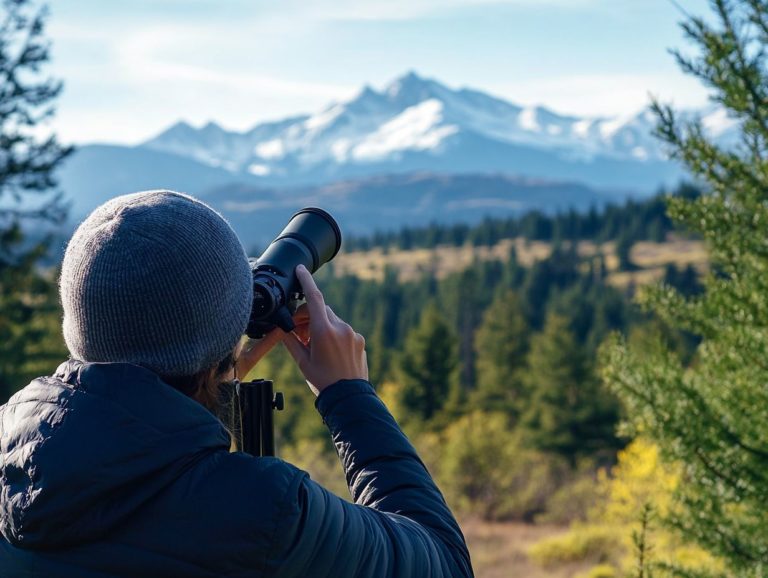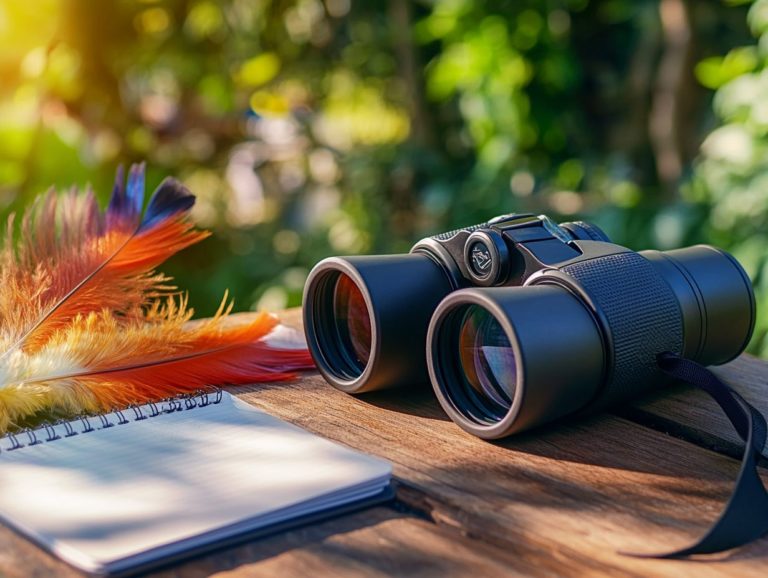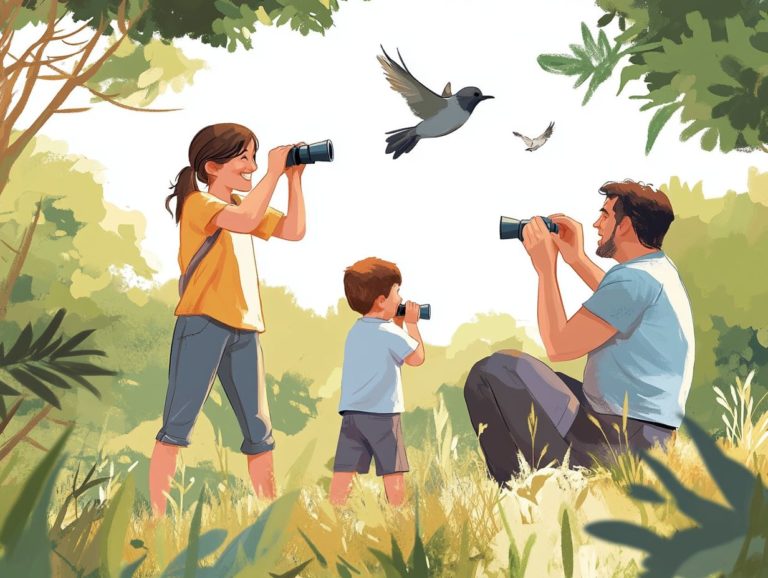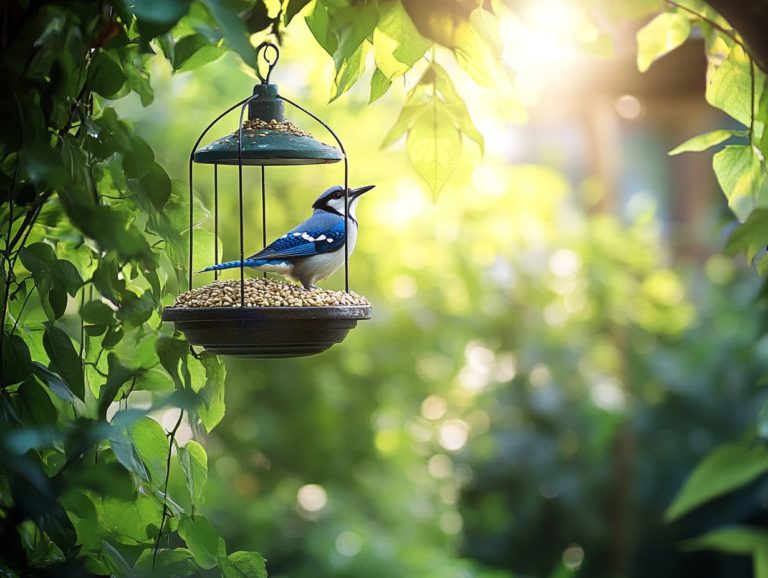6 Bird Watching Techniques to Try This Year
Bird watching is not just a hobby; it is an opportunity to appreciate nature and the diverse range of birds within it. Whether approached as a recreational activity or a serious pursuit, the right techniques can enhance the experience for both novice and experienced bird watchers alike.
This article outlines six effective bird watching techniques, which include:
- Utilizing essential tools such as binoculars and field guides
- Joining clubs and organizations
- Learning to recognize bird calls
Additional methods to improve your bird watching skills encompass:
- Maintaining a bird watching journal
- Leveraging technology
- Learn the fun rules of bird watching to make the most of your adventures!
Contents
- Key Takeaways:
- 1. Start with the Basics: Binoculars and Field Guides
- 2. Join a Bird Watching Group or Club
- 3. Choose the Right Time and Place
- 4. Learn Bird Calls and Songs
- 5. Keep a Birdwatching Journal
- 6. Utilize Technology to Enhance Your Experience
- What Are the Benefits of Bird Watching?
- Frequently Asked Questions
- What are 6 bird watching techniques to try this year?
- How do binoculars enhance the bird watching experience?
- Why is a good field guide important for bird watching?
- How can learning bird calls benefit bird watching?
- What are the benefits of taking nature walks for bird watching?
- How Does Photography Contribute to Bird Watching?
- Why Join a Bird Watching Group?
Key Takeaways:
- Invest in quality binoculars and field guides to enhance your bird watching experience.
- Join a bird watching group or club to learn from experienced birders and discover new locations.
- Timing and location are crucial to successful bird watching, so do your research beforehand.
1. Start with the Basics: Binoculars and Field Guides
Beginning bird watching should start with learning the basics of using binoculars and a field guide. These tools are essential for identifying birds and enhancing your experience in nature.
Whether you are interested in observing backyard birds or traveling to popular bird watching destinations like Lake Erie and the Platte River, having the right equipment will enrich your experiences and allow you to appreciate the feather colors of various Midwest birds, such as the American Coot and the Great Blue Heron.
Quality binoculars should offer clarity, lightweight portability, and an appropriate level of magnification for viewing birds in their natural habitats. A pair with at least 8x magnification and a wide field of view is often recommended for beginners, as it helps capture quick glimpses of birds.
A field guide, such as the Kaufman Field Guide, is essential. It provides valuable information about local species, their behavioral traits, and habitats. New bird watchers should practice using binoculars by focusing on one bird at a time, taking notes, and joining local bird watching groups to learn and enjoy the activity with others.
2. Join a Bird Watching Group or Club
Bird watching groups and clubs, such as those organized by the Audubon Society or local community organizations in Kansas City, are invaluable for connecting with fellow birders and discovering various bird watching tips and resources.
Meeting fellow birders can lead to new friendships and opportunities. Being part of a community allows individuals to learn more about local wildlife from experienced birders who can share insights about specific habitats and seasonal changes that are often overlooked when bird watching alone.
Organized birding events, such as guided walks or educational workshops, provide structured environments for learning. Participants can practice their skills together, enhancing their identification and conservation efforts. These experiences foster a sense of accomplishment and a deeper connection to nature.
3. Choose the Right Time and Place
Choosing the right times and places for bird watching is essential for success. Various species are more active during specific hours, making early morning a prime time for observing birds.
The more one understands seasonal variations, the richer the experience will be. Spring and fall are peak migration seasons, bringing a fascinating mix of species. In the Midwest, hotspots like Shawnee National Forest and Indiana Dunes National Park offer a variety of habitats that attract numerous birds during these crucial times.
Early risers can enjoy the early morning sounds of birds singing, as warblers are often heard around sunrise. Witnessing herons by the lakeshore in the late afternoon can also be a memorable experience. Embracing these optimal times and locations can significantly enhance one’s bird watching experience.
4. Learn Bird Calls and Songs
Learning to identify bird calls and songs is crucial for birdwatching. Many species produce distinctive sounds that help you locate local birds and enhance your experience.
To develop this skill, use birdwatching apps like Merlin Bird ID. These apps give you access to sound libraries and allow you to compare your recordings with extensive databases.
Participating in local workshops or guided birding trips is highly beneficial. Experienced birders share their knowledge and techniques that can enhance your skills.
In your backyard, connect a call with a sighting to reinforce the learning process. Keeping a journal of active birds at different times will also help you identify them better.
The more you track the sounds you hear with the sights you see, the more adept you become at identification.
5. Keep a Birdwatching Journal
Maintaining a birdwatching journal is essential for any birder. It helps track observations, develop a list of species seen, and connect with nature better.
Document important details like the date and location of sightings, the species observed, and comments about their behavior. This thoughtful documentation makes your experiences meaningful.
Your journal evolves from simple notes into a comprehensive account of your experiences. It’s useful for reflecting on seasonal changes and migratory patterns.
Sharing these records with the birding community enhances engagement. It also provides valuable data to others who share your passion.
6. Utilize Technology to Enhance Your Experience
Technology greatly enhances the birdwatching experience. Birdwatching apps and resources, like those from National Geographic, can be very helpful.
The Merlin Bird ID app offers a simple way for birdwatchers to identify species using a few basic prompts. You can log sightings and get a list of species likely found in your area.
Online communities for birdwatchers have flourished. You can share knowledge and experiences, from excursion recommendations to tips on spotting elusive species.
Digital technology, such as interactive maps and regional birding forums, connects birdwatchers and fosters collaboration. Dive in and explore this exciting world!
What Are the Benefits of Bird Watching?
Discover the amazing benefits of bird watching that will elevate your spirit and connect you with nature! Bird watching offers numerous advantages, including a deeper appreciation for nature and wildlife, improved mental health, enhanced social connections within the community, and ethical practices that promote conservation.
Connecting with the environment through bird watching allows individuals to engage with their surroundings. It serves as a beautiful and positive exercise in mindfulness that brings joy and tranquility to often stressful lives.
Birding significantly reduces stress and anxiety. Being in nature also improves mood and cognitive function.
Studies have shown that even simply viewing nature from a window can enhance mental well-being. Bird watching also encourages light to moderate physical activity, promoting cardiovascular health and contributing to overall physical fitness.
Engaging in bird watching educates participants about a diverse array of species. This helps them become more familiar with their local ecosystems and the importance of stewardship.
Birders often develop a love for their environment and recognize the need to protect the diversity of ecosystems worldwide.
Moreover, bird watching fosters social connections. Enthusiasts frequently share tips and experiences, leading to lasting friendships.
Many birders are eager to meet for outings, offer advice, share stories, or even host fellow enthusiasts in their homes. This is especially true in areas where bird watching is a popular activity and enthusiasts travel long distances for viewing opportunities.
Lastly, bird watching presents opportunities for studying and documenting bird behaviors and impacts through citizen science. Citizen science is when everyday people help collect data for research.
By participating in community birding events or citizen science projects, birders become advocates for responsible stewardship. They foster respectful and ethical interactions between humans and wildlife.
What Are the Different Types of Birds to Look Out For?
The Midwest is home to a diverse array of bird species. This includes well-known varieties such as the American Coot, Great Blue Heron, Prothonotary Warbler, and numerous warblers and cranes that migrate through the region.
These bird species can be classified into several categories, including waterfowl, songbirds, and migratory species, each with distinct characteristics.
- Waterfowl like the Mallard and Canada Goose are commonly found in wetlands and are easily recognized by their unique shapes and sounds.
- Songbirds, such as the Eastern Bluebird and American Robin, are noted for their melodious calls.
- Migratory birds like the Sandhill Crane can be spotted in open fields during seasonal migrations.
Observers should pay close attention to plumage, size, and behavior, as these visual cues can significantly aid in identification.
How Can One Identify Birds?
Bird identification techniques involve paying close attention to plumage colors, size, and behavior. Following binocular recommendations can enhance visibility in the field.
Noting habitat, flight patterns, and vocalizations can also aid in bird identification; however, these factors are secondary to the primary identifying characteristics.
Beginners may find it beneficial to invest in a quality field guide specific to their region. This will serve as an invaluable tool for side-by-side comparisons of different species.
A good pair of binoculars can significantly enhance the viewing experience, making it easier to observe and study birds from a distance.
With consistent practice using these techniques, one will ultimately develop a greater appreciation for avian diversity and improve their identification skills.
Join a local bird watching group today and be part of a community that cares for our feathered friends!
What Are the Etiquettes of Bird Watching?
Good birding ethics are essential because they ensure that the natural habitats of local wildlife are respected and preserved. This fosters a positive image of the birding community among the general public.
By following these principles, individuals can enjoy their passion for birdwatching while safeguarding the environments that sustain these birds. It’s crucial to maintain a safe distance from nests and roosting sites. Excessive disturbance can cause unnecessary stress to the birds.
Do not disclose the locations of breeding or migratory sites of vulnerable species. Organizing community workshops on ethical birding helps educate both new and experienced birders.
Reinforcing the significance of these practices cultivates a culture of conservation that benefits both the birds and the people who cherish observing them.
What Are the Common Mistakes Made by Beginners in Bird Watching?
Novice birdwatchers often make mistakes that can detract from their experience. Common errors include failing to identify species accurately, not paying attention to bird behavior, and underestimating the importance of having the right equipment.
To enhance their birdwatching experience, novices should invest time and effort in preparation. Using books that help identify birds and birdwatching apps can help them learn about the species they are likely to encounter.
Additionally, observing how birds feed, mate, and interact with their environments provides crucial context for understanding their behaviors.
Having appropriate equipment, such as binoculars for observing wildlife, will enhance the birdwatching experience. By addressing these common pitfalls, individuals can gain a greater appreciation for birds and build confidence in their birdwatching skills with each outing.
How Can One Support Conservation Efforts Through Bird Watching?
Bird watching directly contributes to conservation efforts in several ways. Bird watchers provide valuable data, participate in local wildlife programs, and raise awareness for habitat protection through organizations like the Audubon Society.
They can collaborate with fellow birders to engage in volunteer opportunities, including habitat restoration and educational outreach programs in schools and communities.
Bird watchers can also participate in citizen science projects to record their observations and help track migratory patterns. Advocating for policies that protect fragile ecosystems is another impactful way to contribute.
The collective efforts of the birding community not only raise awareness but also inspire meaningful action!
Frequently Asked Questions
What are 6 bird watching techniques to try this year?
1. Binoculars: These are a must-have tool for bird watching. They let you see birds up close without disturbing them.
2. Field Guide: A good field guide helps you identify different bird species and learn more about their behaviors.
3. Bird Calls: Learning bird calls can help you locate specific species and communicate with them.
4. Nature Walks: Take a leisurely walk in nature and keep an eye out for birds. You never know what you might spot!
5. Photography: Capture beautiful images of birds with your camera. This technique can also assist with identification.
6. Join a Bird Watching Group: Connect with other bird enthusiasts and learn from their experiences. You may also discover new techniques from them!
How do binoculars enhance the bird watching experience?
Binoculars allow you to see birds in great detail without disturbing their natural behaviors. They also make it easier to spot birds that may be hidden in trees or other foliage.
Why is a good field guide important for bird watching?
A good field guide can help you identify and learn about different bird species, their habitats, and behaviors. It also provides valuable information on migration patterns and vocalizations.
How can learning bird calls benefit bird watching?
Learning bird calls can help you locate specific species and communicate with them. It adds an extra layer of enjoyment to your bird watching experience.
What are the benefits of taking nature walks for bird watching?
Nature walks allow you to immerse yourself in the natural environment and observe birds in their habitats. They also provide opportunities to spot other wildlife and appreciate the beauty of nature!
How Does Photography Contribute to Bird Watching?
Photography lets you capture the beauty of birds and their unique behaviors. It also helps you identify them and share your adventures with others.
Why Join a Bird Watching Group?
Joining a bird watching group connects you with other enthusiasts. You’ll learn new techniques and discover great birding spots.
It’s also a fantastic way to make friends who share your passion.




